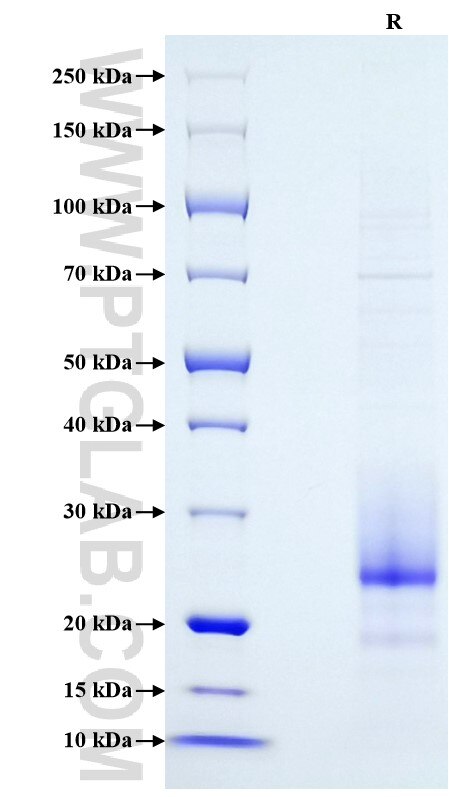Recombinant Human VEGFC protein (Myc Tag, His Tag)
Species
Human
Purity
>70 %, SDS-PAGE
Tag
Myc Tag, His Tag
Activity
not tested
Cat no : Eg32025
Validation Data Gallery
Product Information
| Purity | >70 %, SDS-PAGE |
| Endotoxin | <0.1 EU/μg protein, LAL method |
| Activity |
Not tested |
| Expression | HEK293-derived Human VEGFC protein Thr103-Arg227 (Accession# P49767) with a Myc tag and a His tag at the C-terminus. |
| GeneID | 7424 |
| Accession | P49767 |
| PredictedSize | 19.1 kDa |
| SDS-PAGE | 24-25 kDa, reducing (R) conditions |
| Formulation | Lyophilized from 0.22 μm filtered solution in PBS, pH 7.4. Normally 5% trehalose and 5% mannitol are added as protectants before lyophilization. |
| Reconstitution | Briefly centrifuge the tube before opening. Reconstitute at 0.1-0.5 mg/mL in sterile water. |
| Storage Conditions |
It is recommended that the protein be aliquoted for optimal storage. Avoid repeated freeze-thaw cycles.
|
| Shipping | The product is shipped at ambient temperature. Upon receipt, store it immediately at the recommended temperature. |
Background
Vascular endothelial growth factor C (VEGF-C) is a protein that is a member of the platelet-derived growth factor / vascular endothelial growth factor (PDGF/VEGF) family. The main function of VEGF-C is to promote the growth of lymphatic vessels (lymphangiogenesis). It acts on lymphatic endothelial cells (LECs) primarily via its receptor VEGFR-3 promoting survival, growth and migration. Apart from vascular targets, VEGF-C is also important for neural development and blood pressure regulation.
References:
1. V Joukov. et al. (1996) EMBO J. 1996 Jan 15;15(2):290-98. 2. Barbara Le Bras. et al. (2006) Nat Neurosci. Mar;9(3):340-8. 3. Agnes Machnik. et al. (2009) Nat Med. 15(5):545-52.

